|
| BW Vintage Photo 1900's |
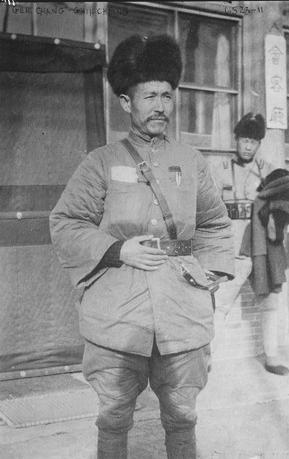
|
| Gen. Chang-Chih-Chiang |
In the history of LiuHe BaFa or of similar naming, a link is
made between Msr Wu Yi-hui and the Nanjing Academy..which gives the false impression that it was about Msr. Wu and LHBF; its
scope of teachings was much broader and the chief person behind the Academy was Army General Chang Chih-chiang.
Central Guoshu Institute: 中央國術館
"The Central Martial Arts Academy, ( simplified Chinese: 中央国术馆;
pinyin: zhōng yāng guˇ sh¨ guǎn; literally "Central Martial Arts Academy"); was established in Nanjing by the
Kuomintang government of the Republic of China in 1928 for the propagation of Chinese martial arts,
and was an important center of martial arts during the Nanjing decade. Guoshu (also spelled Kuoshu)
國術 "national art" was the term for martial arts adopted by the Republic of China at the time.
The institute was headed by five selected masters, including
Fu Chen Sung, Wan Lai Sheng, Gu RuZhang, Li Lie Jun 李烈鈞 (1882–1946), Li Jinglin (李景林,
1884–1931), and Chang Chih Chiang (Zhang Zhi Jiang 张之江, 1882–1966).
Along with the Jing Wu Athletic Association (established in 1910), the academy played a crucial role in the transmission of
traditional Chinese martial arts into the 20th century. In April 1928, The Institute held its first national martial arts
competition in Beijing in the form of a highly competitive lei tai tournament. It was presided by General Zhang Zhi Jiang.
This competition attracted 400 of the best martial artists in China. ,
| Nanjing Guoshu Guan |
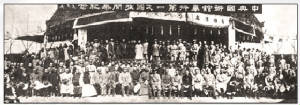
|
| Central Martial Arts Academy, estb 1928, closed 1947 |
| Close up of the Central Academy and its Teachers |
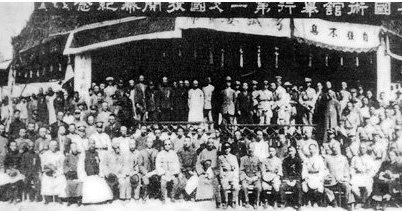
|
Nanking-China
: LiuHeBaFa-exercise system, the creation of Wu YiHui
Historical lineage for the water-style exercise to the LiuHeBaFa qigong-boxing exercise.There is
evidence that water-style in Anhui and Shanghai provinces seems to differ from the 'LiuHeBaFa' system that was taught in Nanking
later. The signifcant aspect of 'water' style, is its' manner of weaving together the basic principles inherent in all 'internal'
styles in a characteristic flowing: swimming-chasing-following.
The story that LHBF originated from Chen Hsi-I [Xi-Yi-] is generally accepted as a myth; there exists no evidence that
teacher Wu did anything to 'deny' this legendary link and the confusion entailed.
Wu YiHui claims to have been taught by three teachers in 'Pianliang', Pinyin adjustment makes it plausible that this was a
mis-spelling of Pianling, which is only about 60 miles of Wu's hometown, Tieling; this can be considered as the modern
'input' of water-style to the 'HuaYo'-XinYi-Liu He Ba Fa boxing-system which is of Nanking, China.
Yan Guo-xing --- 閻國興 --from Henan-----------\
Chen
Guang-di --- 陳光第 -from Hebei ======> Wu Yi -hui 吴翼翚
Chen He-lu --- 陳鶴侣 -from Beijing-----------/
[ Note: this listing may be somewhat misleading as other evidence
states that Wu learned also Lu Hong boxing between studies of LHBF variations. It should also be stated that the 'mythic' history leading back to the Song Dynasty is
at best incomplete and that to some extent was 'believed' by Wu as a respect to his teachers. This practice of 'going
along with the hearsay is common but only propagates a 'said' story that is without any real basis.]
Public-Emergence: exercises taught are a matrix of qigong, with martial principles gathered through the teachers and friends
of Wu YiHui, then Director of the Nangking Academy of Martial Arts. It is generally surmised that upon qigong principles
and forms, the LHBF of Wu YiHui includes elements from LiuHe-XinYi and its' auxilliary 'animal' forms, elements
and principles from taichi and from Mi Zong-I BaGua; additional external exercises where adapted [to internal], from
several southern 'swimming-dragon' styles incusive. This collective body of exercises is now only taught by lineage successor
Choi Wai-Lun as taught to him by Chen YikYan of Hong Kong; Choi does have extensive prior experience with Lama boxing.
LiuHeBaFa Exchange with Auxilliary Styles :
Wu Yi-Hui, in creating the modern LiuHeBaFa-system, added training forms [ external-styles reworked by Wu as 'internal';
the most likely source of these exercises was via the teacher resource available at the Central Academy. ]
>LuHong's Eight-Link Palms/ Fists 'tendency' 呂紅八勢拳
LuHong BaShi-
>Coiled Dragon Swimming 螫龍遊 Zhe Long
You -
>Coiled Dragon Fist 螫龍拳 Zhe Long Chuan
-
>Dragon and Tiger Fighting 龍虎戰 Long
Hu Zhan -
>3-levels, 12-Animal forms 三盤十二勢
SanPan ShiEr Shi -
Wu YiHui had contact with other master-teachers of inner force style martial-exercises; at the Academy and outside of the
school.
>Xing-Yi teacher: Ch'u Kuei-Ting, Nanking
>Ba-Gua teacher:
Chiang Jung-Ch'aio, Nanking
>Yi-Quan-Zhan Zhuang : Wang Xiang-Zhai, Shanghai
>Yi-Quan-Zhan Zhuang : Han Xing-Chiao,
Nanking
[and teacher-to-teacher exchanges with Sun LuTang at the school and each afternoon for tea conversations.]
| Nanking Martial College -before 1950 |
|
|
| Teacher-Exchange |
National College of Martial Arts in Nanking
Back row ( L-R ):
Chan YikYan (Wu Yik Fan's LHPF protege, Wai Lun Choi's teacher)
Han
Hsing-Ch'iao (Yi Quan, LiuHo PaFa; elder brother of Han XingYuan)
Yin T'ien-Hsiung (Lu Hung's Eight-Link
Palms ).
Front row ( L-R ):
Chiang Jung-Ch'aio (Pa Kua,
Hsing-I, Tai Chi), Director of Programs
Wu Yik Fan (Liu Ho Ba Fa Founder), Dean of Studies
Chang Chih-Chiang
(Liu Ho Pa Fa), Chancellor
Ch'u Kuei-Ting (Hsing-I, Pa Kua)
Chang Chih-Chiang, Chiang Jung-Ch'iao, Chen Yik Yan, Yin T'ien-Hsiung
were all Liu Ho Pa Fa students of Wu Yik Fan.
Before Wu Yik Fan, Chen Yik Yan had studied Tai Chi, Hsing-I
and Pa Kua
with Chiang Jung-Ch'iao, Ch'u Kuei-Ting and Han Hsing-Ch'iao.
Yin T'ien-Hsiung was generally accepted as specializing in LuHongEight Fist.
Comment: the depth of skill exerperience among these teachers is not evident from the photograph
nor does it indicate the event context; China was shifting from a Manchu Imperium to a Kuo Ming Tang Republic with conflicts
of Japanese military incursion and subversive usurping of all of 'China' by the Communist.
Ch'u Kuei-ting : Chu Kuei Ting 袺桂亭
(1892-1977) Chu Gui-ting
Associate Teacher: Hsing-I, Pa Kua
One of the disciples of Li Cunyi, From Danzhou
town, Renqiu County, Hebei.
References:
| Chu Keui Ting as Elder |
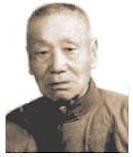
|
| Chiang Styled Ba Gua Turning Patterns |
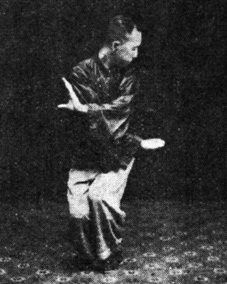
|
Chiang Jung Ch'aio : Chiang Jung Chiao 姜容樵 (1891-1974)
( Jiang Rong-Qiao
) Also known as Chiang Kuan Wu.
Associate Teacher:
Pa Kua, Hsing-I, Tai Chi-
Professor Jiang was not known as a fighter, but as a prolific writer
of books.
" Jiang produced a very intelligent system of Bagua and had a superior understanding
of martial mechanics and power development " During his youth he learned Mi Tsung Chuan, Lost Track Boxing. There may
have been some influence of this upon teacher Wu Yi-hui.
Professor Jiang also wrote a forward for Chen Yi Ren’s 陳亦人
book entitled “Liuhe bafa Chuan”, published September 1st, 1969. where he offers up a 'truer' origin for the
Nanjing LHBF exercise.
References :
| Notable Photo Gathering of Prominent Teachers |
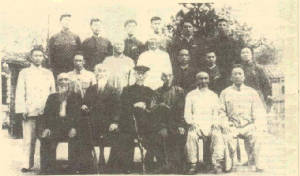
|
| First Row, Third Teacher with Hat, is Msr Jiang |
Yin T'ien-Hsiung : Yin Tien Xiong 尹天雄
'Whan Tin Hung' Yin Tian Jue.
Nanjing Academy 'specialist' student, ie. LuHong BaShi- 呂紅八勢拳 LuHong Fist 呂紅拳.
Some, refer to this exercise as '8-Link Fist' or as Lu Hong Ba Tsu Quan. Msr. Teacher Lu Gui-yao also refers to it as Yang
Cheng boxing 陽城拳勢.
The official lineage is cited as being through Wu Yi-hui. The claim that
LH8 predates LHBF is false; first records indicate the Ming Dynasty.
[Note: there exists more than
one version; one being rendered more simple; also, many 'teachers' tend to stylize LH8 as a xingyi- or xinyi-boxing...which
LH8 is not. A lineage from Ba-Chi- has been suggested.]
References:
Formidible Fighter:
Student of Lau Sam Muk and Chan Yik Yan in Hong Kong, David
Chan {Oct 1950 - 25 Dec 2012] relates in his biography of his relation with Yin Tian-xiong as a sparing partner and that
either Yin or himself were chosen to 'defend' the schools integrity. Alan Orr also did an article interviewing Dr. Mark Riley
about Msr. David Chan.
"The best fighter of Hong Kong Hwa Yu Xinyi Liuhebafa Association
was Yin T’ien Hsiung, who Master David called the Lu Hong Master. Yin T’ien Hsiung was a disciple of Wu Yi Hui,
When other Kung Fu schools challenged Lau Saam Mok’s school, it is usually Master David who first faces the opponent,
being the best fighting student during his time, but it is Yin T’ien Hsiung the Lu Hong Master who is really the official
fighter of the school."
"Yin T’ien Hsiung was a small man, as Master David would repeatedly
tell us when we enter history mode, but a very crazy and formidable fighter. Master David would describe a typical day when
he arrived in his school, Lau Saam Mok will be Standing in Meditation at one area, senior students teaching other students
dance moves of Liuhebafa, Xingyi, BaGua, etc., and on another area Yin T’ien Hsiung will be practicing the Lu Hong Eight
Postures Style, and when Yin T’ien Hsiung sees Master David he would call him over to practice with, teaching Master
David applications and how to comprehensively use Lu Hong. Master David was a disciple of Lau Saam Mok, but he was also the
favorite sparring partner and learner of Yin T’ien Hsiung. The Lu Hong Master loved teaching Master David how to fight
using Lu Hong. Even when Master David was with Lau Saam Mok, the Lu Hong Master would call him to come over and start talking
and teaching Lu Hong Pa Shih. In essence Master David was like a disciple of Yin T’ien Hsiung, and their relationship
was an influence that contributed a lot to our Xinyi Meditation fighting style."
References:
A Notable 'Mafia' Linkage:
Beginning in 1726, trade and commercial organizations which sought to control transportation and vice activities
by coercive means existed and became notable in Shanghai and Nanjing; these were known as the Green Gang 青幫
qing-bang and the Red Gang 红帮 hong-bang. Rivalry was suspended as both groups joined forces with Sun Yat-sen’s
revolutionaries. Both Sun Yat-sen and General Chiang Kai-shek were Green Gang members.
Yin T'ien-Hsiung was a member of the Green Gang.
The Green Gang was often hired by Chiang Kai-shek's Kuomintang to break up union meetings and
labor strikes and was also involved in the Chinese Civil War. Carrying the name of the Society for Common Progress,[1] it
was — along with other criminal gangs — responsible for the White Terror massacre of approximately 5,000 pro-Communist
strikers in Shanghai in April 1927, which was ordered by Nationalist leader Chiang Kai-shek. The Green Gang was a major
financial supporter of Chiang Kai-shek, who became acquainted with the gang when he lived in Shanghai from 1915 to 1923. The
Green Gang shared its profits from the drug trade with the Kuomintang after the creation of the Opium Suppression Bureau.
[ Pub: The Shanghai Green Gang: Politics and Organized Crime, 1919-1937]
References:
General Chang-Chih-Chiang 張之江
(1882 – 1966) Zhang Zhi jiang (张之江)
References:
A Brief History of Wu Style Tai Chi Chuan
"Following
the success of the Northern Expedition [1926-1927] the Central Guoshu Institute headed by Li Ching Lin and Chang
Chih Chiang was established in Nanjing. This institute always invited Master Wu Chien Chuan
to sit on the judges committee during Guoshu examinations.
References:
http://www.wustyle.com/en/about
| Army General Chang Chih-chiang |
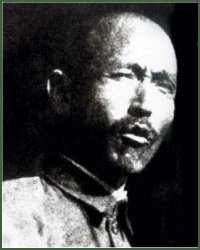
|
| Promoter and Conservator of Chinese Martial Arts |
|

